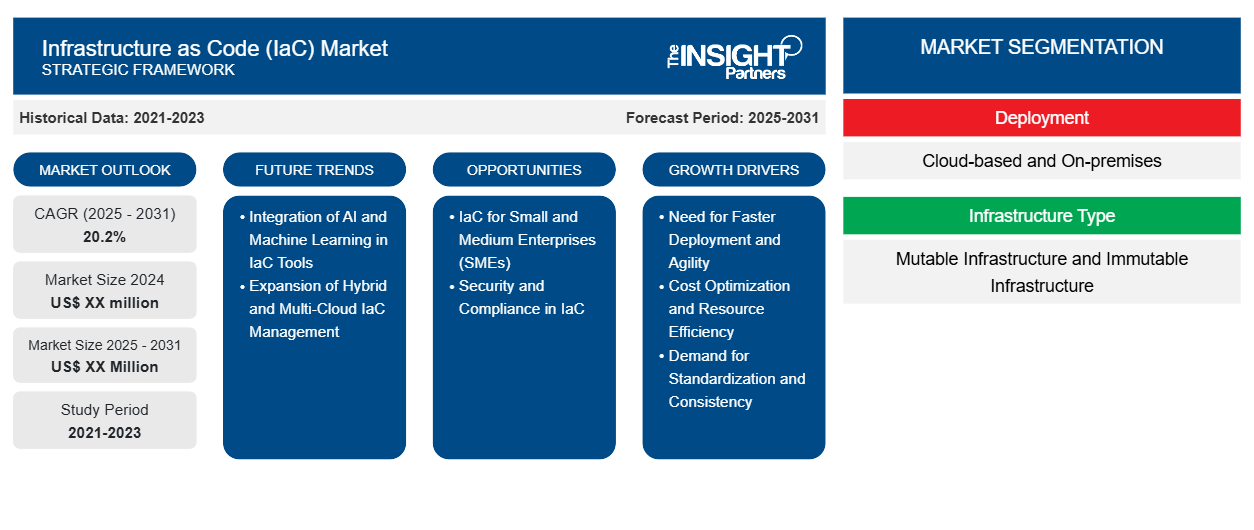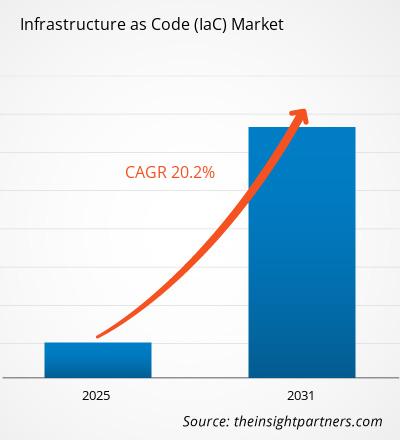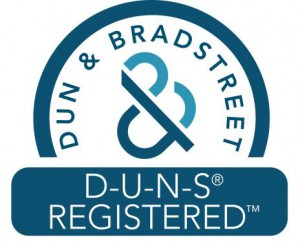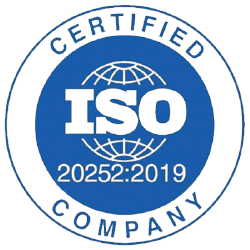The Infrastructure as Code (IaC) Market is expected to register a CAGR of 20.2% from 2025 to 2031, with a market size expanding from US$ XX million in 2024 to US$ XX Million by 2031.
The report is segmented By Deployment (Cloud-based and On-premises), By Infrastructure Type (Mutable Infrastructure and Immutable Infrastructure), By Approach (Imperative and Declarative), By End-user (BFSI, Retail, Government, Manufacturing, IT & Telecom, Healthcare, and Others). The global analysis is further broken-down at regional level and major countries. The report offers the value in USD for the above analysis and segments
Purpose of the Report
The report Infrastructure as Code (IaC) Market by The Insight Partners aims to describe the present landscape and future growth, top driving factors, challenges, and opportunities. This will provide insights to various business stakeholders, such as:
- Technology Providers/Manufacturers: To understand the evolving market dynamics and know the potential growth opportunities, enabling them to make informed strategic decisions.
- Investors: To conduct a comprehensive trend analysis regarding the market growth rate, market financial projections, and opportunities that exist across the value chain.
- Regulatory bodies: To regulate policies and police activities in the market with the aim of minimizing abuse, preserving investor trust and confidence, and upholding the integrity and stability of the market.
Infrastructure as Code (IaC) Market Segmentation
Deployment
- Cloud-based and On-premises
Infrastructure Type
- Mutable Infrastructure and Immutable Infrastructure
Approach
- Imperative and Declarative
End-user
- BFSI
- Retail
- Government
- Manufacturing
- IT & Telecom
- Healthcare
You will get customization on any report - free of charge - including parts of this report, or country-level analysis, Excel Data pack, as well as avail great offers and discounts for start-ups & universities
Infrastructure as Code (IaC) Market: Strategic Insights

-
Get Top Key Market Trends of this report.This FREE sample will include data analysis, ranging from market trends to estimates and forecasts.
Infrastructure as Code (IaC) Market Growth Drivers
- Need for Faster Deployment and Agility: Organizations are increasingly focused on accelerating software development cycles and improving time-to-market. IaC enables faster provisioning, deployment, and scaling of infrastructure, facilitating DevOps and continuous delivery pipelines. This drive for agility and streamlined operations in IT environments significantly boosts the IaC market.
- Cost Optimization and Resource Efficiency: IaC automates infrastructure management, reducing the need for manual interventions and minimizing resource wastage. This leads to improved resource efficiency, cost savings, and better utilization of cloud services. As businesses look to optimize operational costs, the adoption of IaC grows.
- Demand for Standardization and Consistency: IaC enables the standardization of infrastructure deployments across environments (e.g., development, testing, production). By codifying configurations, it ensures consistent infrastructure setups, reducing configuration drift and errors, and enhancing overall system reliability. This demand for consistent and repeatable processes drives IaC adoption.
Infrastructure as Code (IaC) Market Future Trends
- Integration of AI and Machine Learning in IaC Tools: The integration of AI and machine learning technologies into IaC solutions is expected to grow. These technologies can optimize resource allocation, predict infrastructure needs, and automate anomaly detection. AI-driven IaC tools will enhance operational efficiency, reduce downtime, and streamline the process of managing complex infrastructure environments.
- Expansion of Hybrid and Multi-Cloud IaC Management: As organizations adopt hybrid and multi-cloud strategies, managing infrastructure across different cloud environments will become more complex. IaC solutions will evolve to support seamless management across hybrid and multi-cloud architectures, enabling organizations to provision, configure, and manage infrastructure across diverse cloud providers and on-premises environments.
Infrastructure as Code (IaC) Market Opportunities
- IaC for Small and Medium Enterprises (SMEs): While large enterprises have adopted IaC solutions, there is a significant opportunity to provide tailored, user-friendly IaC tools for small and medium-sized enterprises (SMEs). These solutions can help SMEs automate infrastructure management, reduce manual intervention, and ensure consistency without requiring extensive technical expertise or large budgets, making IaC more accessible to a broader market.
- Security and Compliance in IaC: As IaC tools automate infrastructure provisioning, they must also ensure security and compliance. Offering IaC solutions that integrate security best practices, vulnerability scanning, and compliance checks will create opportunities in sectors such as finance, healthcare, and government, where security and regulatory compliance are critical. This niche market will see significant growth as security becomes a primary concern in infrastructure management.
Infrastructure as Code (IaC) Market Regional Insights
The regional trends and factors influencing the Infrastructure as Code (IaC) Market throughout the forecast period have been thoroughly explained by the analysts at The Insight Partners. This section also discusses Infrastructure as Code (IaC) Market segments and geography across North America, Europe, Asia Pacific, Middle East and Africa, and South and Central America.
Infrastructure as Code (IaC) Market Report Scope
| Report Attribute | Details |
|---|---|
| Market size in 2024 | US$ XX million |
| Market Size by 2031 | US$ XX Million |
| Global CAGR (2025 - 2031) | 20.2% |
| Historical Data | 2021-2023 |
| Forecast period | 2025-2031 |
| Segments Covered |
By Deployment
|
| Regions and Countries Covered |
North America
|
| Market leaders and key company profiles |
|
Infrastructure as Code (IaC) Market Players Density: Understanding Its Impact on Business Dynamics
The Infrastructure as Code (IaC) Market is growing rapidly, driven by increasing end-user demand due to factors such as evolving consumer preferences, technological advancements, and greater awareness of the product's benefits. As demand rises, businesses are expanding their offerings, innovating to meet consumer needs, and capitalizing on emerging trends, which further fuels market growth.

- Get the Infrastructure as Code (IaC) Market top key players overview
Key Selling Points
- Comprehensive Coverage: The report comprehensively covers the analysis of products, services, types, and end users of the Infrastructure as Code (IaC) Market, providing a holistic landscape.
- Expert Analysis: The report is compiled based on the in-depth understanding of industry experts and analysts.
- Up-to-date Information: The report assures business relevance due to its coverage of recent information and data trends.
- Customization Options: This report can be customized to cater to specific client requirements and suit the business strategies aptly.
The research report on the Infrastructure as Code (IaC) Market can, therefore, help spearhead the trail of decoding and understanding the industry scenario and growth prospects. Although there can be a few valid concerns, the overall benefits of this report tend to outweigh the disadvantages.
Frequently Asked Questions
What are the options available for the customization of this report?
What are the deliverable formats of the market report?
What are the future trends of the infrastructure as code (iac) market?
What are the driving factors impacting the global infrastructure as code (iac) market?
What is the expected CAGR of the infrastructure as code (iac) market
- Historical Analysis (2 Years), Base Year, Forecast (7 Years) with CAGR
- PEST and SWOT Analysis
- Market Size Value / Volume - Global, Regional, Country
- Industry and Competitive Landscape
- Excel Dataset
Recent Reports
Testimonials
Reason to Buy
- Informed Decision-Making
- Understanding Market Dynamics
- Competitive Analysis
- Identifying Emerging Markets
- Customer Insights
- Market Forecasts
- Risk Mitigation
- Boosting Operational Efficiency
- Strategic Planning
- Investment Justification
- Tracking Industry Innovations
- Aligning with Regulatory Trends





















 Get Free Sample For
Get Free Sample For